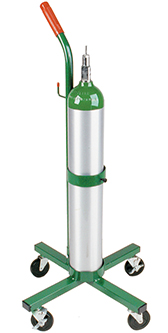
Selecting the right oxygen cart depends on several factors that directly impact safety, efficiency, and user experience. The choice between mobility options affects daily operations, whether in medical facilities, industrial settings, or home care environments.
Understanding your specific requirements helps narrow down the best option for your situation. Different wheel configurations offer distinct advantages depending on usage patterns, terrain, and load requirements.
Understanding Two Wheel Oxygen Cart Advantages
A two wheel oxygen cart provides a compact, lightweight solution for transporting gas cylinders in tight spaces. These units excel in environments where storage space is limited and frequent lifting or maneuvering around obstacles is required.
The streamlined design of a two wheel oxygen stand allows users to navigate narrow hallways, doorways, and confined areas with greater ease than bulkier alternatives. This makes them particularly suitable for residential use or smaller medical facilities.
Key benefits of two-wheeled models include:
- Reduced storage footprint when not in use
- Lighter overall weight for easier handling
- Lower initial purchase cost
- Simpler maintenance requirements
- Better performance on stairs and uneven surfaces
- Enhanced portability for transport between locations
Four Wheel Oxygen Cart Stability Benefits
A four wheel oxygen cart delivers superior stability and weight distribution, making it the preferred choice for heavier gas cylinders or multiple cylinder transport. The additional wheels provide a stable platform that reduces the risk of tipping during movement.
The design of a four wheel oxygen stand incorporates a wider base that distributes weight more evenly across the surface. This configuration proves particularly valuable when transporting larger cylinders or when the cart will remain stationary for extended periods.
Four-wheeled models offer enhanced user comfort during transport, as they require less physical effort to maneuver. The improved weight distribution reduces strain on the user and provides smoother rolling action across various floor surfaces.
Weight Capacity Considerations
Load capacity requirements play a significant role in determining the appropriate wheel configuration. Two-wheeled models typically handle lighter loads effectively, while four-wheeled versions accommodate heavier cylinders and multiple units simultaneously.
Standard oxygen cylinders vary in weight from 8 pounds for portable units up to 150 pounds for large industrial cylinders. Understanding the maximum weight you’ll transport helps determine whether additional wheels are necessary for safe operation.
Consider not just the cylinder weight, but also the frequency of transport and the physical capabilities of users. Heavier loads benefit from the stability and ease of movement that four wheels provide.
Mobility and Maneuverability Factors
Different environments demand varying levels of maneuverability. Tight spaces, multiple floor surfaces, and frequent direction changes all influence the optimal wheel configuration choice.
Two-wheeled units excel in situations requiring quick direction changes and navigation through narrow passages. They perform well on carpeted surfaces and can handle minor obstacles more effectively than their four-wheeled counterparts.
Environmental factors that favor two-wheeled models:
- Narrow corridors and doorways
- Multiple floor surface transitions
- Frequent stair navigation requirements
- Limited storage space availability
- Regular transport between different buildings
- Areas with numerous obstacles or furniture
Storage and Space Requirements
Available storage space often determines which configuration works best for your situation. Two-wheeled models require significantly less storage area and can fit into smaller closets, corners, or wall-mounted storage systems.
Four-wheeled units need more dedicated storage space but often include additional features like cylinder securing mechanisms or accessory storage areas. Consider both active use space and storage requirements when making your selection.
The footprint difference becomes particularly important in residential settings where space is at a premium. Smaller units can be stored in bedrooms, bathrooms, or other compact areas without creating obstacles.
Cost Analysis and Budget Planning
Initial purchase price varies between two and four-wheeled models, with simpler designs typically costing less than more complex alternatives. However, consider long-term value when evaluating options.
Two-wheeled models generally offer lower upfront costs and reduced maintenance expenses due to fewer moving parts. Four-wheeled versions may justify higher initial investment through improved durability and reduced user fatigue over time.
Factor in replacement costs, maintenance requirements, and potential productivity improvements when calculating total cost of ownership. The right choice balances initial investment with long-term operational benefits.
Making the Right Choice for Your Needs
Successful selection requires honest assessment of your primary use case, physical capabilities, and environmental constraints. No single solution works optimally for every situation, making careful evaluation important.
Consider creating a checklist of your specific requirements including weight capacity, storage space, primary use location, and user physical capabilities. This systematic approach helps eliminate options that don’t meet your core needs.
Anthony Carts specializes in manufacturing high-quality oxygen transport solutions designed for reliable performance across various applications. Our experienced team can help you select the optimal configuration for your specific requirements and ensure you receive a product that delivers long-term value and safety.
Contact Anthony Carts today to discuss your oxygen cart needs and discover how our specialized transport solutions can improve your cylinder handling efficiency while maintaining the highest safety standards.

